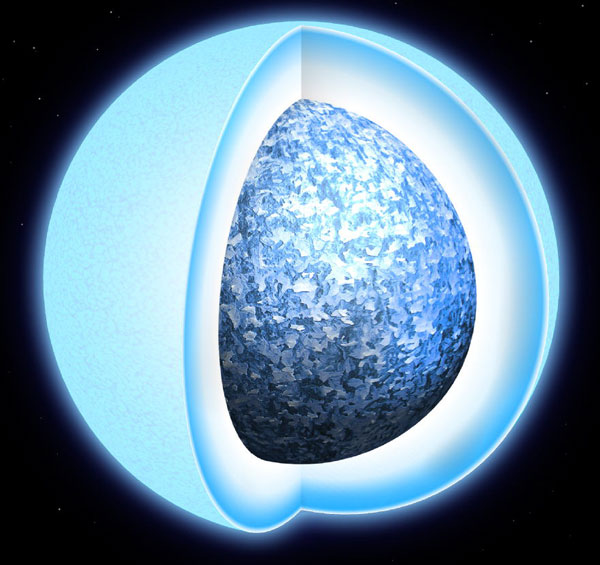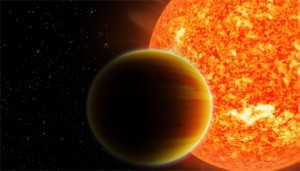This week in astronomy news, space telescopes showed us that white dwarfs are crystallizing in their cores and cloudy night skies are universal among hot Jupiters.
White Dwarfs' Crystal Cores
White dwarfs are the roughly Earth-size stellar cinders that remain after a red giant sheds its outer layers in a planetary nebula. Our Sun will face this fate in 5 billion years, but we still have much to learn about what that fate looks like.

University of Warwick / Mark Garlick
When Gaia revealed precise distances, and thus luminosities, for 1.7 billion stars last year, it also measured these properties for 200,000 white dwarfs — a thousandfold increase compared to what was previously available.
Now, results based on Gaia data and appearing in the January 10th Nature show that thousands of white dwarfs are turning to crystals in their cores. (Based on these findings, the Sun will crystallize, too, in about 10 billion years' time.)
The evidence for this change comes from a diagram that plots magnitude (a measure of luminosity) against color (a proxy for temperature). Pier-Emmanuel Tremblay (University of Warwick, UK) and colleagues placed 15,000 white dwarfs within 300 light-years of the Sun on this diagram, finding that they fall exactly where certain evolutionary models had predicted.
These models suggest that at a certain temperature, white dwarf cores should experience a phase transition. White dwarfs are already pretty exotic — they pack so much matter into so small a space that the atomic nuclei pack together into a kind of fluid. The electrons, meanwhile, become unbound and form a sort of gaseous haze. The phase transition happens once the white dwarf cools below 10 million degrees (and that takes awhile): the nuclei fluid solidifies. Moreover, the nuclei release heat as they settle into an ordered structure, just as freezing water releases energy as it orders its molecules. Thus the crystallizing core actually delays the overall cooling of the white dwarf. Once the core is fully solid, cooling resumes.
Read more in the University of Warwick's press release.
All Hot Jupiters Have Nightside Clouds

Haven Giguere / Nikku Madhusudhan
A new study of KELT-1b, a brown dwarf 27 times the mass of Jupiter that circles its star in just over a day, has surprising implications for hot Jupiters: universally cloudy night skies.
Thomas Beatty (University of Arizona) and colleagues used the Spitzer Space Telescope to watch the brown dwarf as it orbited its star. As it passed in front of the star, then behind it (twice), Spitzer's infrared images reveal the temperature of the tidally locked world's dayside and nightside. The brown dwarf is more massive than hot Jupiters but roughly the same size, so Beatty expected that the nightside ought to radiate heat more slowly. The result would have been a smaller temperature difference between the dayside and nightside than is seen in hot Juptiers, where differences can be as large as thousands of degrees.
Instead, Beatty announced this week at the American Astronomical Society meeting in Seattle, KELT-1b's temperatures fit right in with the hot Jupiter trend, showing a large temperature difference between day and night. Moreover, its nightside temperature is roughly the same as most hot Jupiters: 1000 degrees.
How can worlds with different masses and distances from their stars all have the same nightside temperature? Beatty suggests that clear days and cloudy nights are the answer. Moreover, the temperature difference in KELT-1b is sharp, which suggests that transition happens quickly: clouds form right away at dusk and burn off in the morning.
Note that KELT-1b and hot Jupiters in general are quite outside our solar system experience. Jupiter, for example, has clouds all the way down. What would it look like if it were clear? "You'd have scudding clouds coming over from the nightside, and the dayside would be hazy and blue from Rayleigh scattering," Beatty explained at the press conference. The nightside clouds would be different, too. The alien worlds are so hot, their clouds could be made of silicate vapor, or possibly manganese.
Read more in Beatty and colleagues paper, available on the arXiv.
 1
1









Comments
Tom Kellogg
March 4, 2019 at 9:01 pm
A thousand fold increase of know white dwarfs!!!!!!!! This is amazing news that should be announced in the headlines. Thank you Monica for your thorough and well written articles.
You must be logged in to post a comment.
You must be logged in to post a comment.